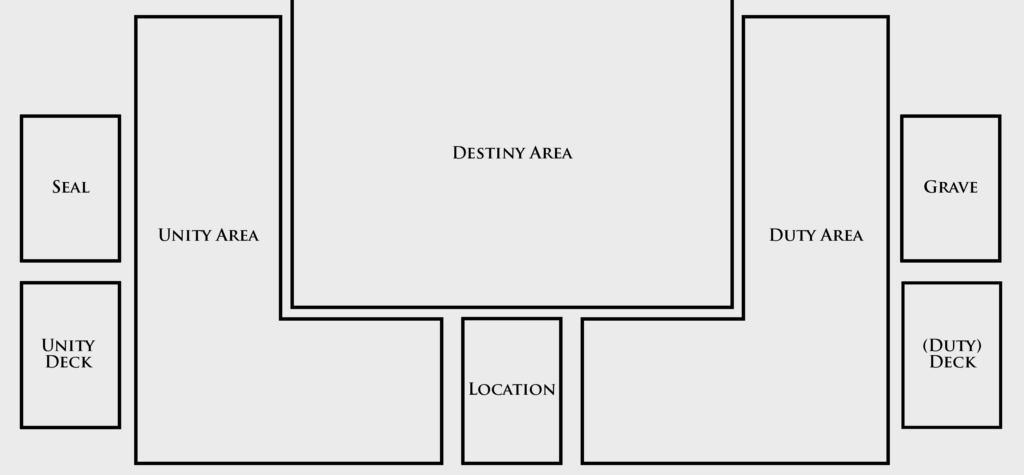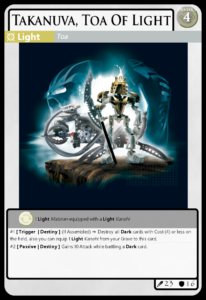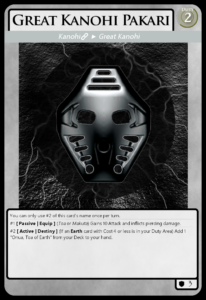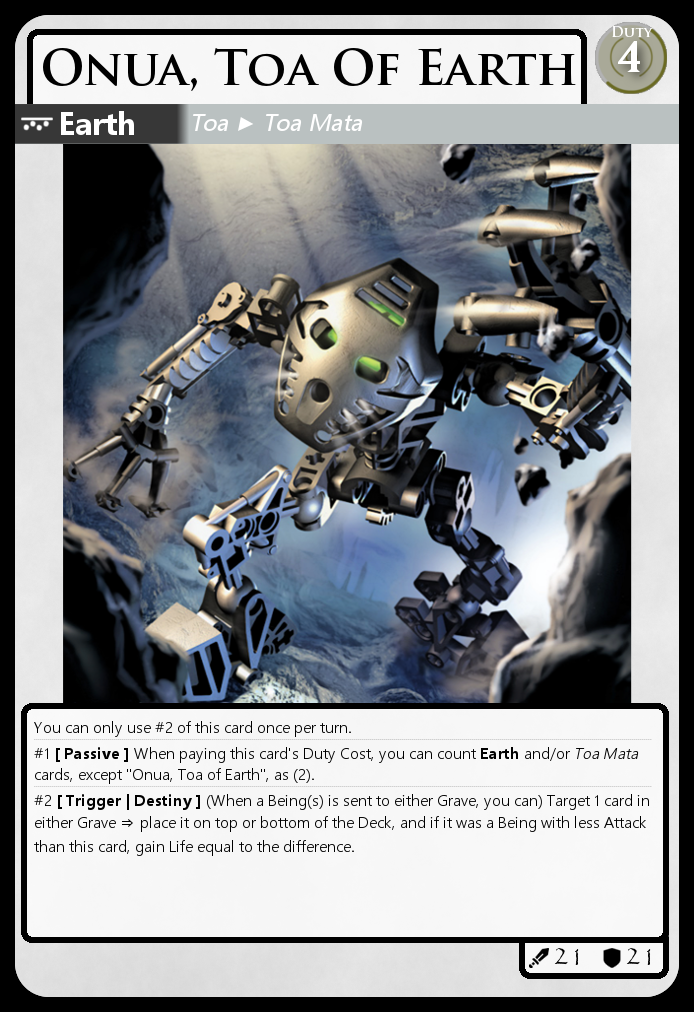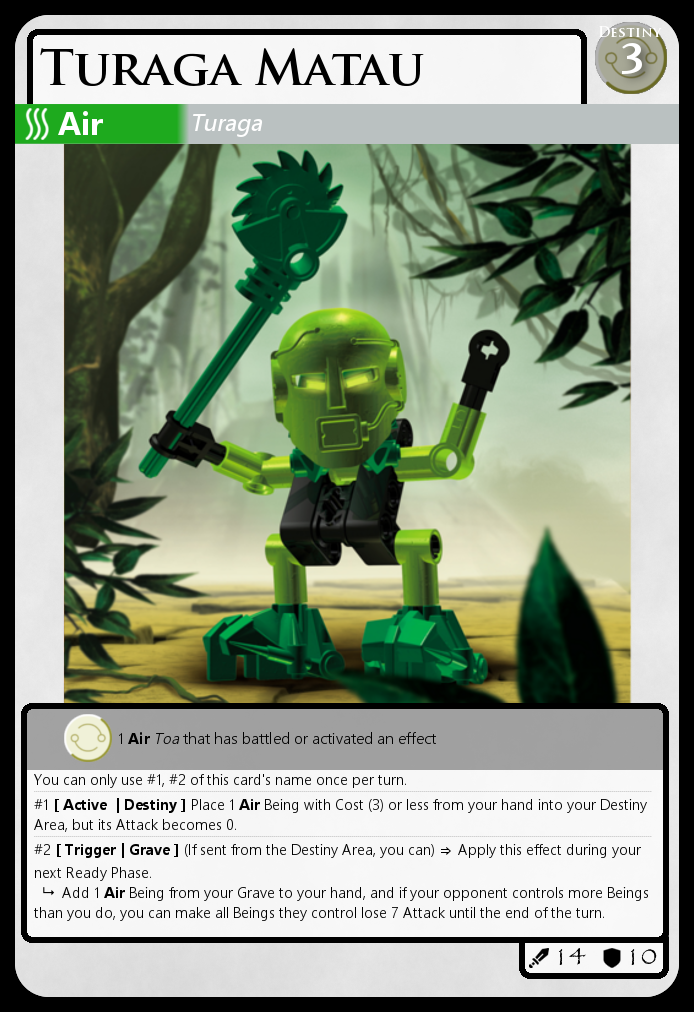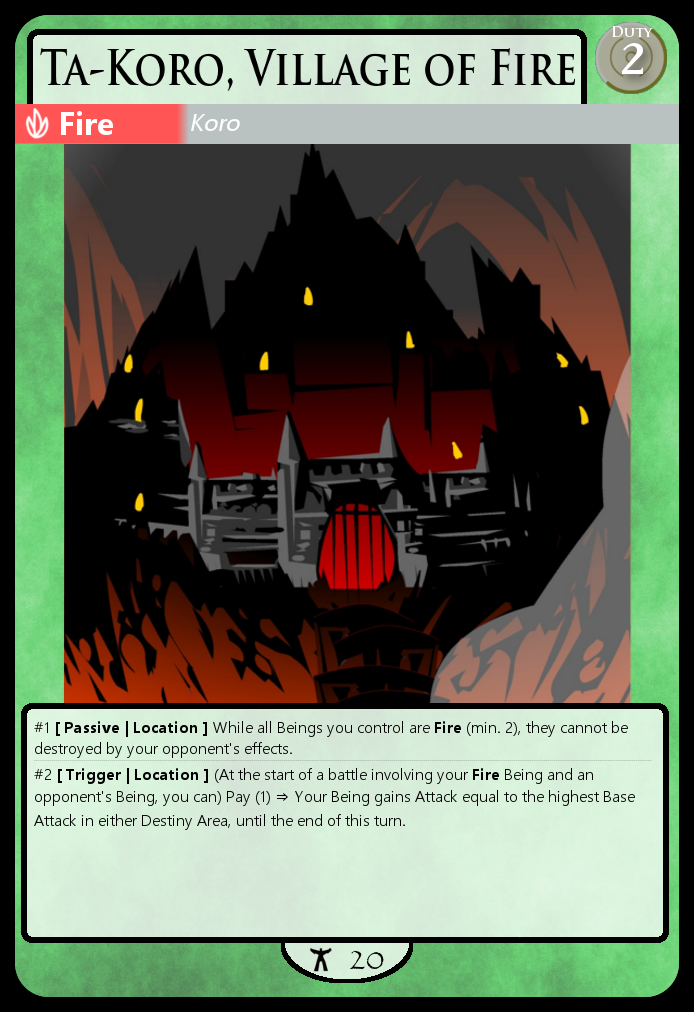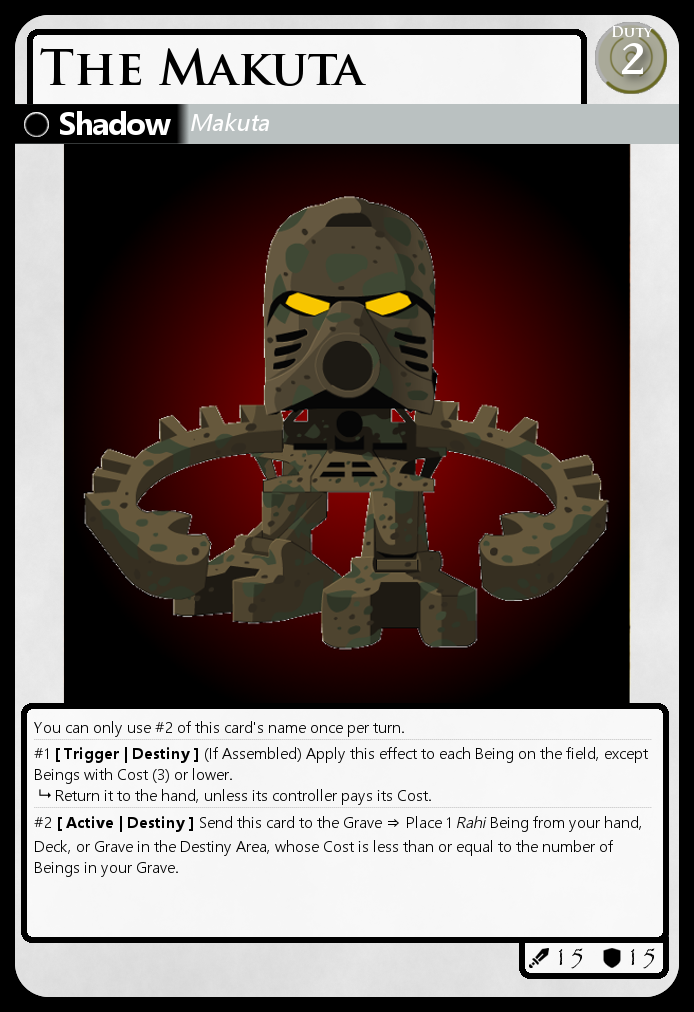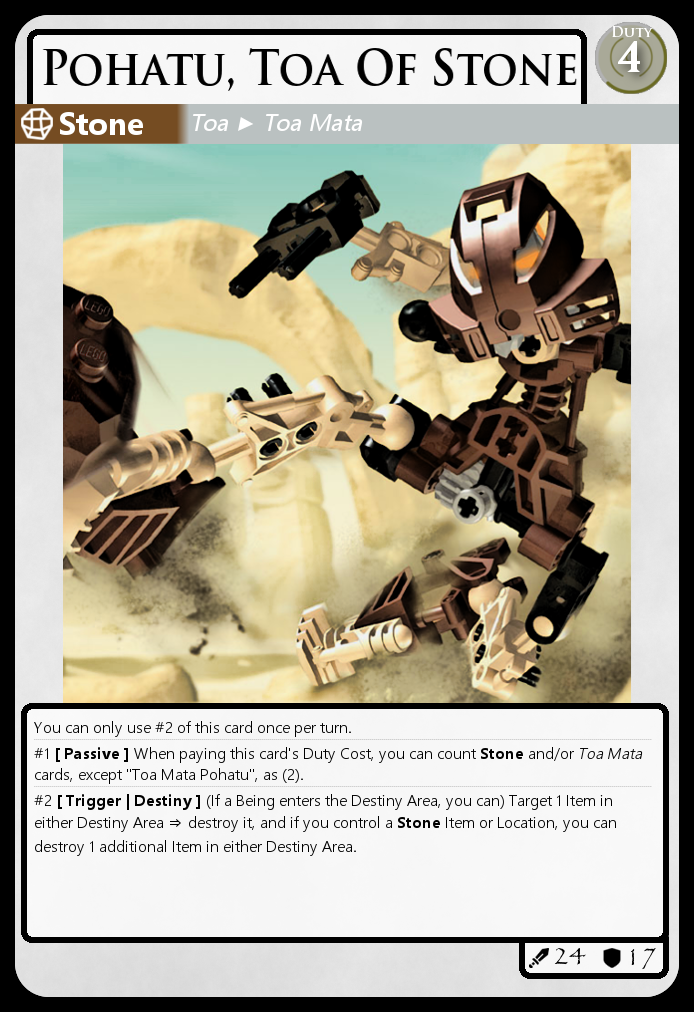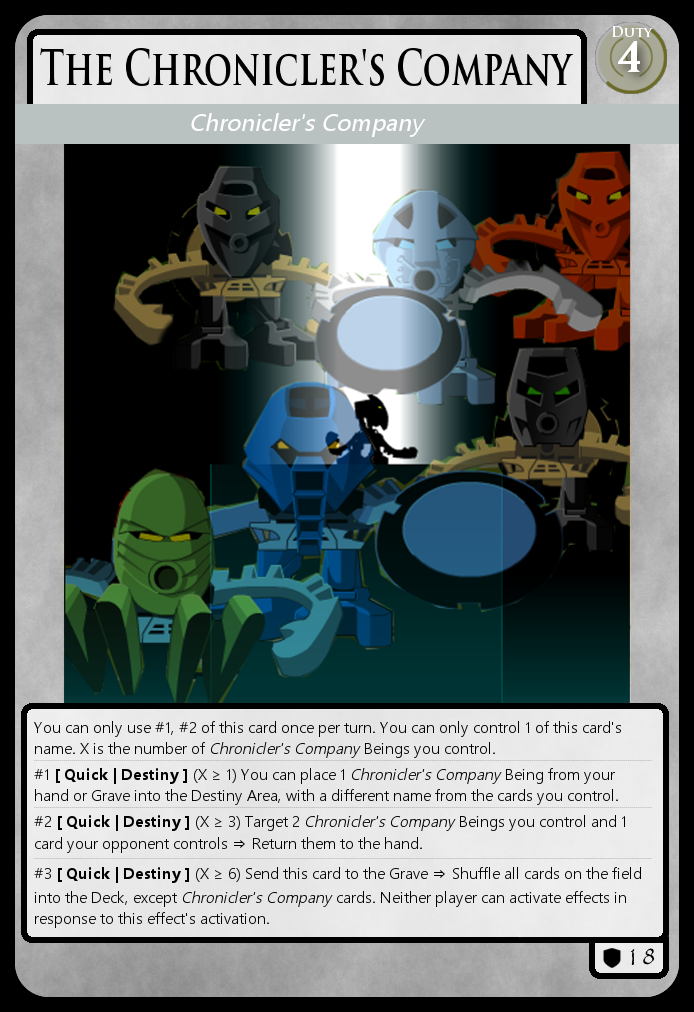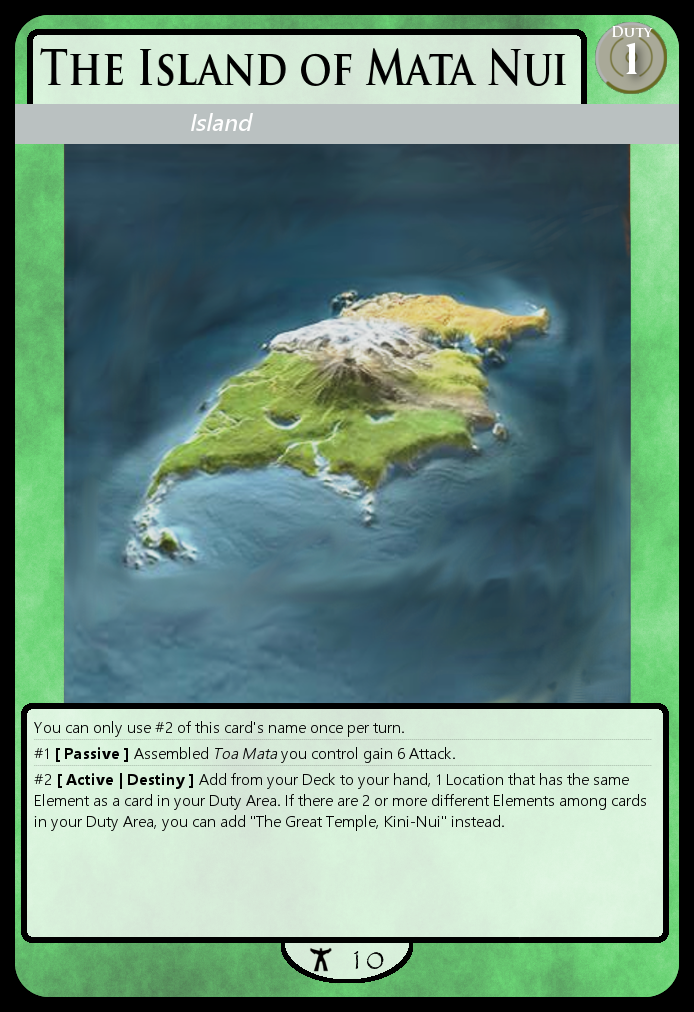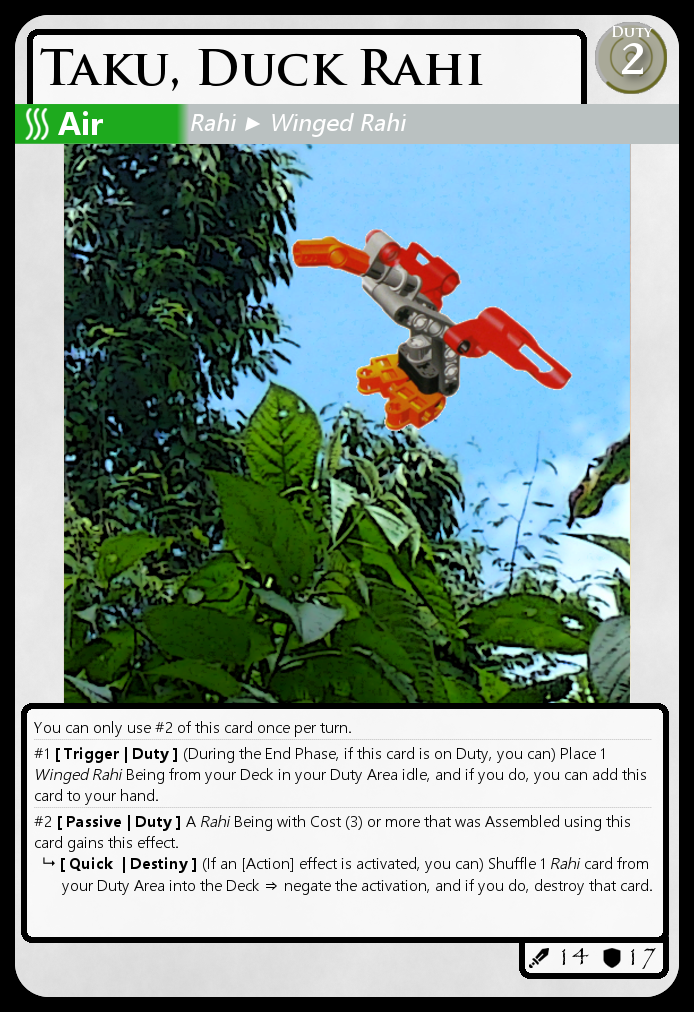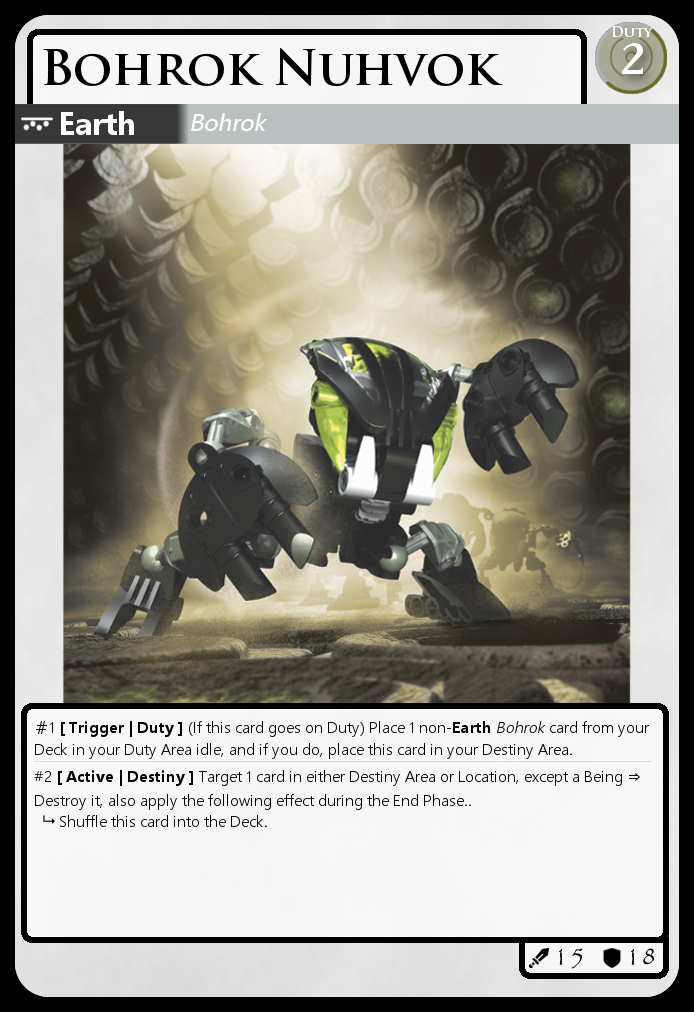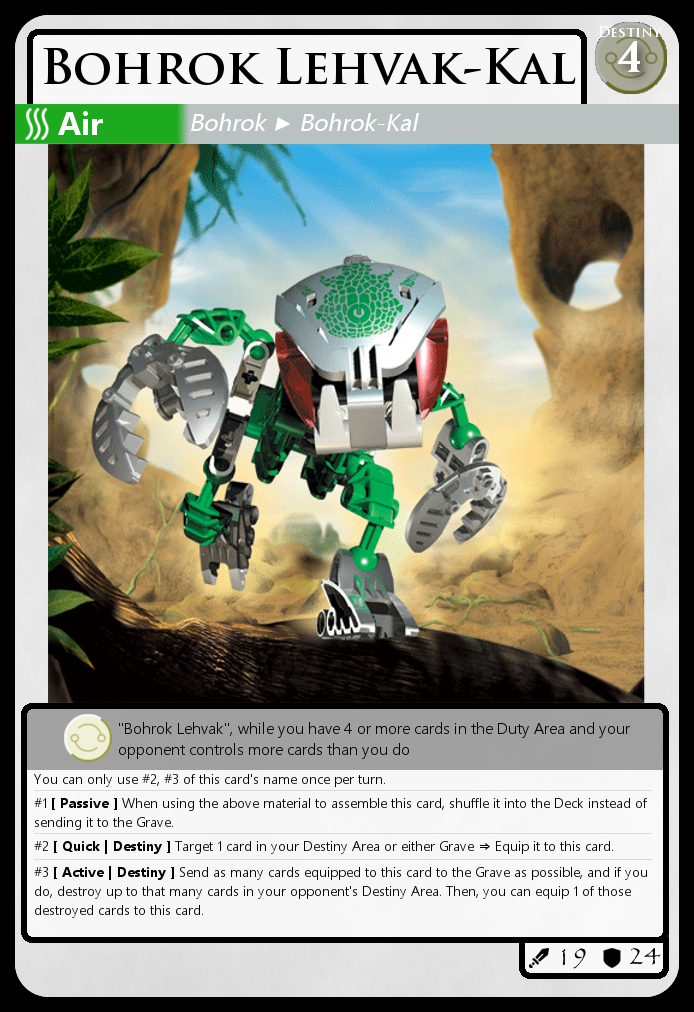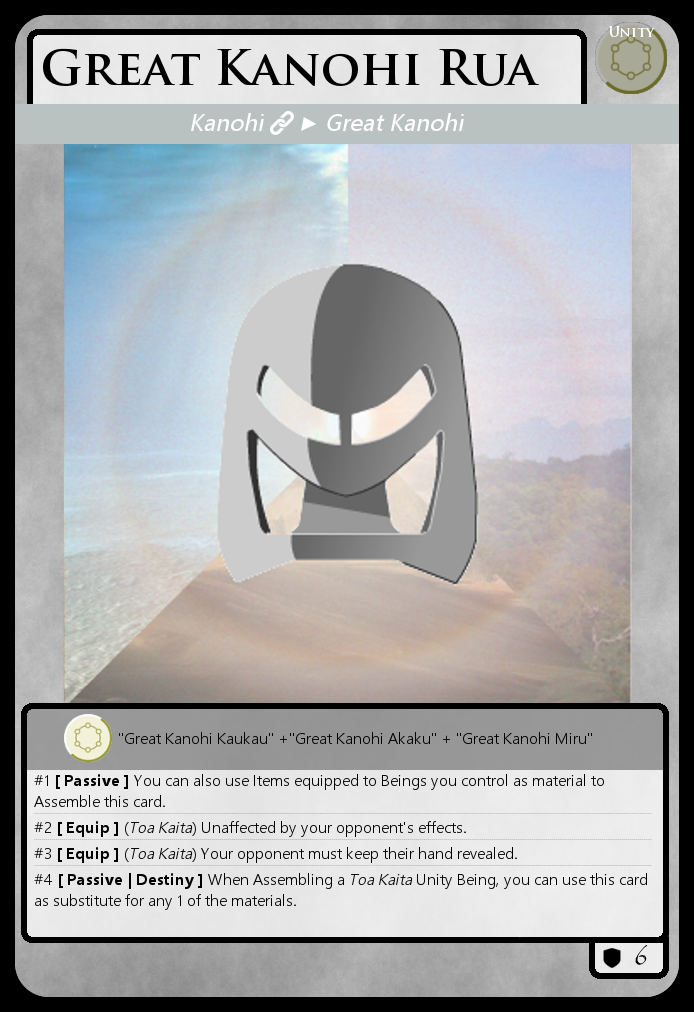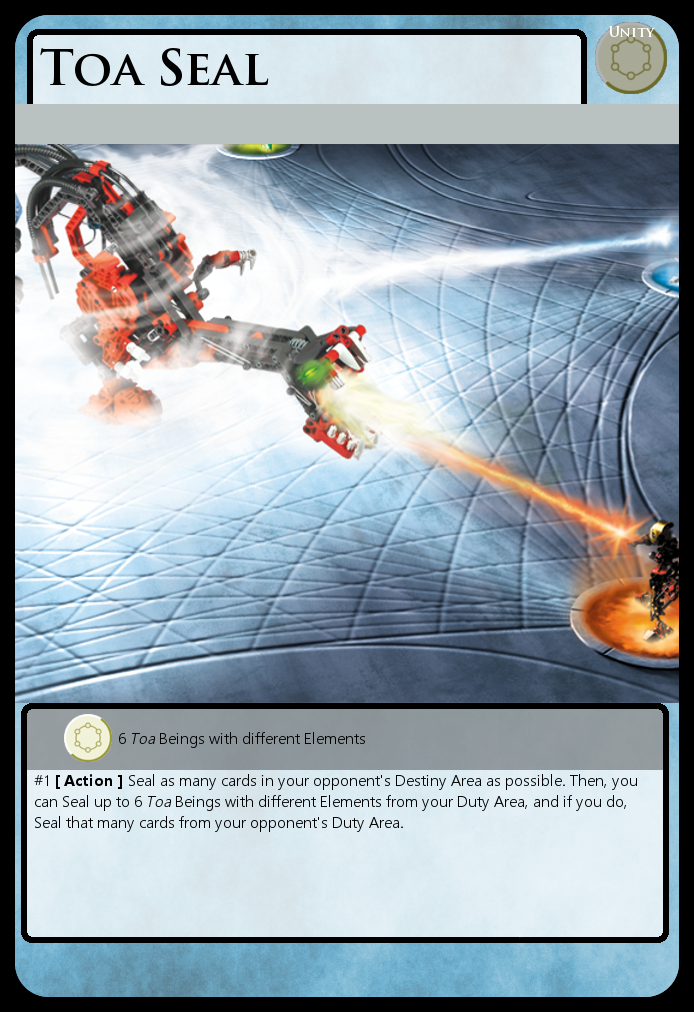The Bionicle YGOPro Expansion, unsurprisingly, is all about designing cards for specifically the game of Yugioh. Which is fun and has been going well, but between the scope of the topic that is Bionicle lore and the project’s rather slow and steady progress, I have sometimes worried about the risk that the actual game may meet its demise and fall out of relevance before I’m done over here. Not looking like that’s happening anytime soon, but with strange aeons …
So what do we do in that case? One option is to just keep going and enjoy not having new product releases continuously changing the landscape I’m trying to design for, but I feel like it might be hard to maintain my or anyone else’s interest in the long term when working on a static corpse. Another is moving the project to any of the countless other similar card games that exist, but honestly there’s a reason I picked this one, and anything else would just feel like a downgrade in terms of how well it accommodates the source material.
The third, my favourite, and the one that means the most work, is the following: I make my own card game, with blackjack and hookers. And so, presenting “Virtues”, an original CCG made from and for the legend of the Bionicle.
What’s a CCG?
The acronym stands for “collectible card game”, a type of game that can be traced back to 1993’s Magic the Gathering. Since then, the concept has inspired a wide variety of titles that add their own twists to it, but broadly speaking they all can be described as follows:
Players pick from a large pool of cards with different properties and abilities to construct a deck that they then use to face off against another player. Over the course of the game, cards are played according to some basic ruleset to interact with each other and the players. The winner is the first player to achieve some fixed goal, which often means reducing a specific resource on their opponent’s end to zero.
And then things get complicated because cards have text on them.
Great. With all that established, let’s see how our own cards look.
Card Properties
Card Type
In most CCGs, and especially in this one, cards represent the building blocks of a story that is told as the game unfolds. So if we want to begin by figuring out what types of cards there are, the question we have to ask is “what types of building blocks does our story need?”. In that regard, I think the storylines of Bionicle – and really most other stories – can be reasonably generalized to the following form:
Someone uses something somewhere to do stuff.
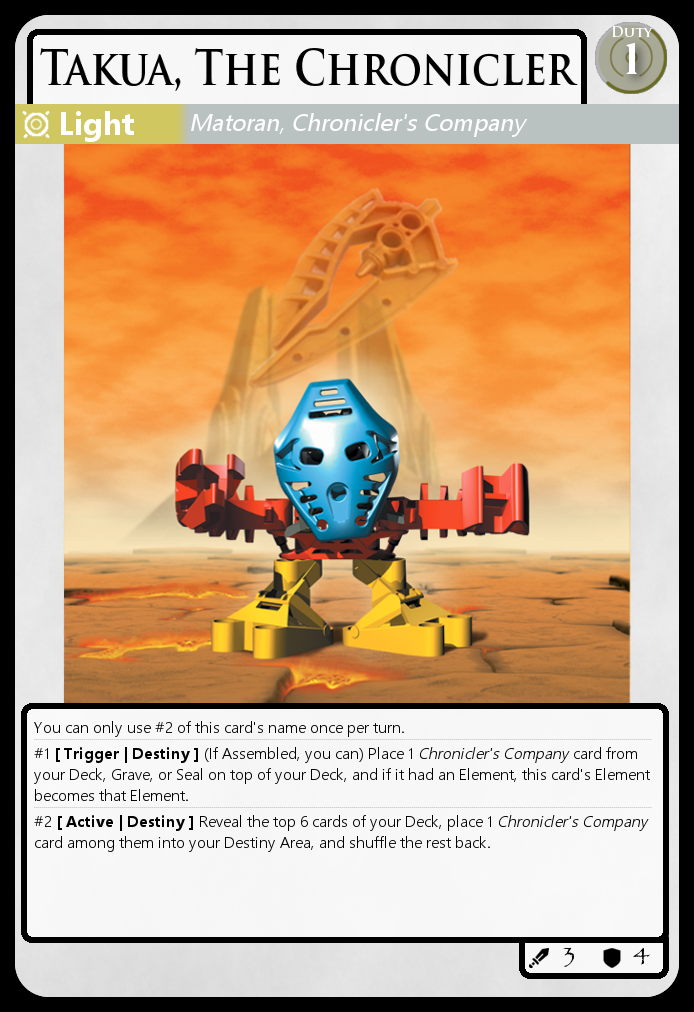
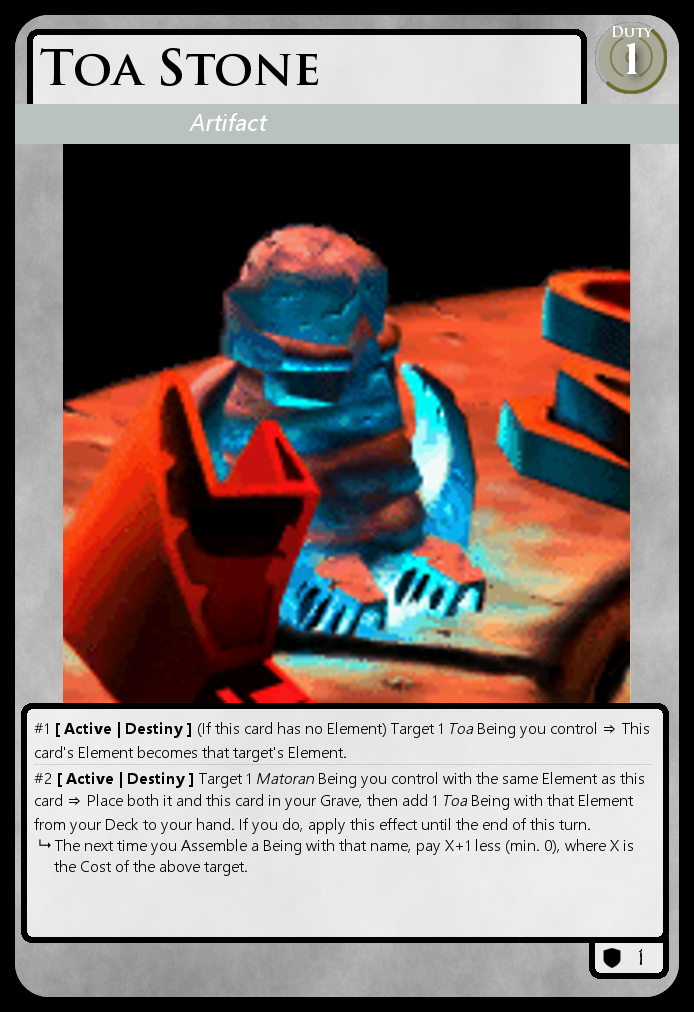
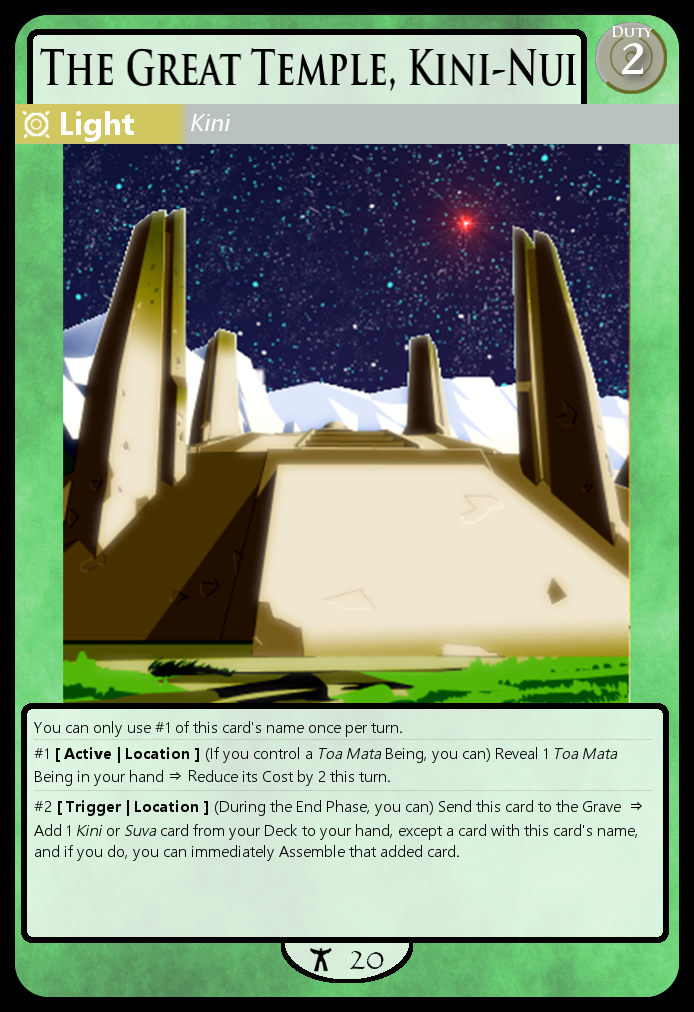
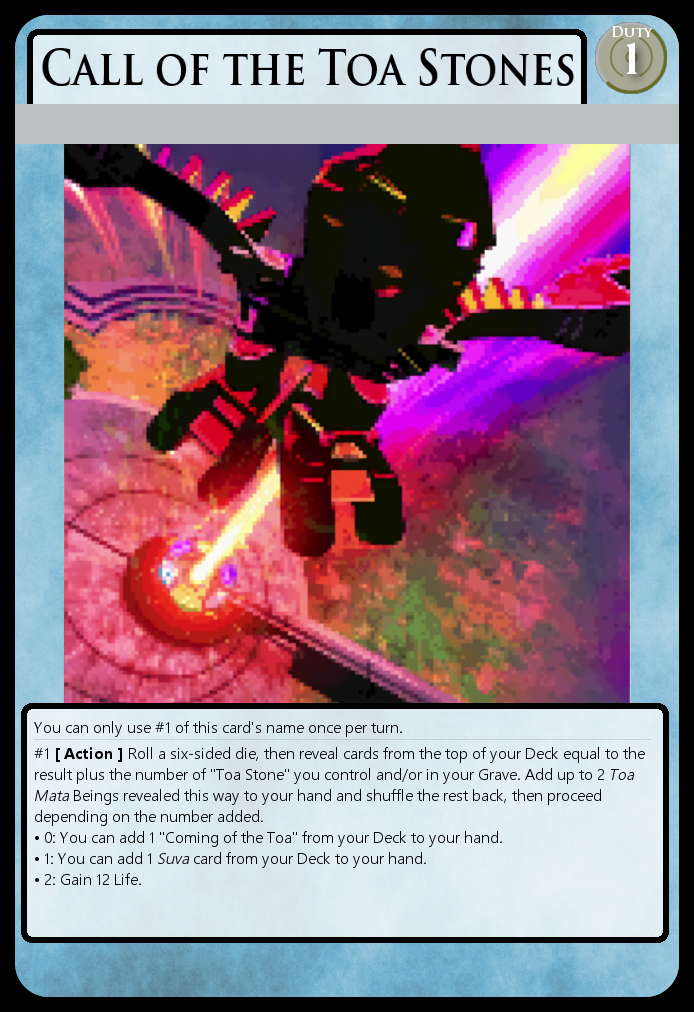
From that, we can derive four different types of cards:
- Beings – Represent the characters in the story (“someone”). These cards have a white frame, are played onto the field, remain until removed by some means, and actively engage in battles.
- Items – Represent inanimate, mostly physical objects in the story (“something”). These cards have a gray frame and stay on the field permanently just like Beings, but do not themselves play an active role in battles.
- Locations – Represent the setting of the story (“somewhere”). These cards have a green frame and are played into a dedicated zone from where they influence the game.
- Actions – Represent things that happen in the story (“do stuff”). These cards with a blue frame are played onto the field only briefly, resolve their listed action(s), and then immediately proceed to the Grave.
In Yugioh terms, this is roughly equivalent to a division into Monsters, Continuous Spells/Traps plus Equip Spells, Field Spells, and then all other Spells/Traps. Important disclaimer: The interpretations of what each card type represents are only a guideline, and exceptions based on gameplay considerations are always possible.
Generic Properties
Most of the information that can be found on a card is actually universal to all card types. Some – the name, the image, and the card text – are obvious, so let’s proceed right to the more interesting ones.
In the top right corner, you have an icon and number denoting the cost of the card. Which tells us that, like most CCGs and unlike Yugioh in particular, this game comes with a general system of costs that must be paid in order to use cards. While such a fundamental difference is naturally going to make recycling existing designs a little harder, I wanted to include a cost system just because coming up with one is a lot of fun, and I must say I’m quite satisfied with the result. More on that later, as it’s not something that can be explained while looking only at the cards. For now, just remember this kind of icon labeled with “Duty” and the number 1 indicates a Duty Cost of 1.
Below the name, we can find two different types of descriptive properties. Leftmost, highlighted with an icon and colored background, stands the card’s Element – this can be Fire, Water, Earth, Wind, Light, or Dark, but also Stone, Ice, and all other manner of nonsense – in some cases it may even be blank. The remaining space with the gray background lists any number of groups, which can also include subgroups (denoted as e.g. Toa > Toa Mata). These two properties are frequently used to identify cards in card text, with one special piece of terminology being that two cards sharing either the same element or at least one group are said to match each other.
Combat Stats
Specific to Beings and Items is the block of stats at the bottom of the text box. For Beings, who can both attack and be the target of attacks, it consists of both Attack and Defense values. For Items, who can be targeted for attacks but not attack by themselves, there is only Defense.
At this point we should probably talk about how battling works a bit. In yet another break from Yugioh, I have decided to handle the stats in a way more similar to MtG: Defense acts like a little health bar for each card, and a battle involves the two combatants dealing their Attack worth of damage to each other’s Defense. It’s just a nice storytelling device that allows depicting various scenarios – teamwork, damage resistance, poison, and regeneration are just some examples of concepts that can be neatly implemented through battle-related effects this way.
As far as battles in general are concerned, instead of also copying Magic’s system of attackers and blockers, I’d prefer to go with something less involved. A good candidate is the system of Shadowverse, where Attack/Defense stats work as previously described, but also target selection is simply left to the attacking player much like in Yugioh.
There are, of course, many more aspects to consider with this central design element. Do we have summoning sickness? Is there a dedicated Battle Phase? Under which conditions can you directly attack the opponent’s life points? But such things are best figured out in the process of actual testing, of which I did none. So yeah.
Location Level
The number underneath the textbox of a Location is unrelated to combat, as Locations go into their own separate zone where they can neither attack nor be attacked. Instead, this value represents the Location’s “zoom level”, and to explain this I have to elaborate a bit on how Locations work. Take a look at the Mata Nui Field Spell on the Yugioh side of things:
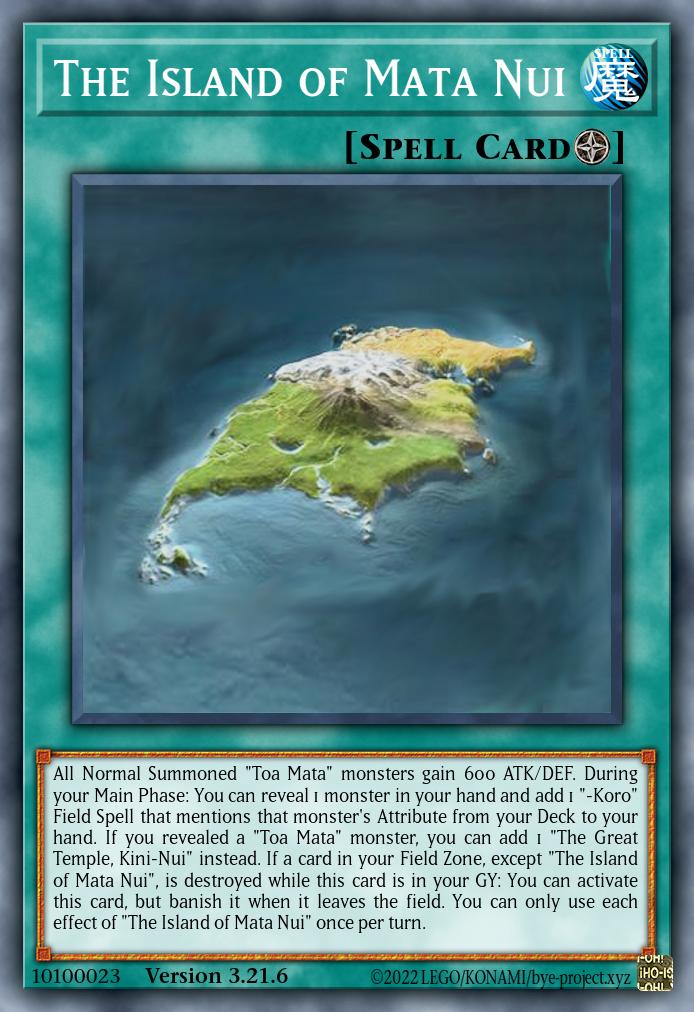
The Island of Mata Nui
Field SpellAll Normal Summoned “Toa Mata” monsters gain 600 ATK/DEF. During your Main Phase: You can reveal 1 monster in your hand and add 1 “-Koro” Field Spell that mentions that monster’s Attribute from your Deck to your hand. If you revealed a “Toa Mata” monster, you can add 1 “The Great Temple, Kini-Nui” instead. If a card in your Field Zone, except “The Island of Mata Nui”, is destroyed while this card is in your GY: You can activate this card, but banish it when it leaves the field. You can only use each effect of “The Island of Mata Nui” once per turn.
One of its effects searches you the Field Spell of a particular village on the island (“zoom in”), while another is able to bring the island back to the Field Zone later (“zoom out”). This kind of dynamic with locations that exist within other relevant locations is something that occurs all the time in Bionicle’s story, so I’d like to have it implemented on the level of game mechanics rather than card effects.
Which is where the Location Level comes in: If you have an active Location, and you play another Location with a higher Level, it is simply stacked on top of that active Location. Only the topmost layer of the stack actually applies its effects and interacts with the field, but if it’s ever removed, you simply fall back to the layer below it. On the other hand, if a new Location you’re trying to play does not have a higher Location Level than the active one, you will be required to remove cards from the stack until you reach a Location for which that is the case – essentially zooming out and then back in.
Card Text
We previously brushed this one aside as “obvious”, but that of course meant only as far as its inclusion on every type of card is concerned. After all, card text is what truly makes the game go round and the source of most of the things that actually occur when you’re playing. So a fair amount of consideration is needed when it comes to layout, format, and structure of these texts. To summarize my stance on a few relevant points:
- Structure: Please yes. There’s no good reason to make it just one big paragraph.
- Keywords: Sparingly, but don’t shy away from them either.
- Icons: Please no. At least not as a way to replace words in the big main text box.
Basically, the goal is to maintain the very useful property of “reading the card explains the card”, while still doing what we can to simplify said reading.
Let’s start with some simple ways to add structure to a card text. What Yugioh does in the OCG, and for some reason not in the TCG, is numbered effects – so you can clearly see where each of them starts and ends. We’re definitely copying that, as well as the practice of listing meta-restrictions like once-per-turn clauses in a leading sentence using those numbers. Additionally, if space allows, putting a line break and some kind of visible separator between effects further helps everything look clean and orderly.
In the effects themselves, I would like to extract two particular pieces of generic information so they can be found at a glance: The type of the effect, and the location(s) where it can be used. Maybe things like costs and conditions could also receive some special highlighting.
For instance, a Yugioh effect of:
If you control no monsters: You can discard 1 card; Special Summon this card from your hand or GY.
might all in all take on this form:
[Active | Hand, Grave] (If you control no Beings) Discard 1 => Place this card in your Destiny Area.
With this format, a quick scan of the [bold bracketed] parts on the left edge of the text box already tells you which parts are actually relevant in a given game state. The activation condition for this “Active” effect is in (parentheses) because it has no bearing on the actions you need to perform when using the effect, and the cost (paid at activation) is split from the effect (performed at resolution) by a nice bulky “=>”, acting much like the “;” in PSCT.
We’ll see various effect types and tentative standard wordings while looking at sample cards, so I won’t bore you with a dictionary at this point. The idea of how card texts are built should be clear from this brief introduction, at least.
The Field
Now that we know the cards, it’s time to look at where they’re played, and how. Virtues gives each player a field that looks like this:
We’ll go into some detail about the marked locations and the mechanics that involve them, but for starters here’s a quick overview:
- (Duty) Deck: The standard main deck from which you draw.
- Unity Deck: The Extra Deck equivalent, containing an always available pool of cards you can form by “combining” other cards.
- Destiny Area: The main “battlefield” where you play cards in order to beat your opponent.
- Duty Area: Used to pay the Duty Costs of the cards played into the Destiny Area.
- Unity Area: Used when playing cards from the Unity Deck – the materials go here.
- Location: The special zone where Location cards are played and stacked on top of each other.
- Grave: Where spent cards go; the GY (duh).
- Seal: Alternative place cards can be removed to, usually by effects; the banishment.
The Deck (and drawing cards)
There’s a lot that could theoretically be said about the Deck, or “Duty Deck” as its full name would be. How small or large can it be? How many copies of each card are you allowed to play? How many cards do you draw at the start of the game? How many each turn?
All valid questions, and all questions I have not studied enough to make any kind of statement that’s not a random guess. So, leaving out specific numbers, we can just say your opening hand of X cards comes from here, and then presumably you draw an additional one at the start of each of your turns.
Destiny
Now this is really getting into the meat of things. The Destiny Area, located right in the middle of the combined board formed by both players’ fields, hosts the core of the gameplay. In the story you carve out as you play, the cards placed here are the heroes fighting to fulfill their destiny.
The main way to get a card – specifically a Being, Item, or Action – into the Destiny Area from your hand is to pay its Duty Cost (more on that in a moment). Once you have done so, you can put the card into any part of your Destiny Area; there are no zone divisions or limits planned here at the moment (though I can’t say I’m not slightly tempted to open up the super fun design space that is columns). If the card is a Being or Item, it stays there until otherwise removed. If it’s an Action, you apply its effect and then put it straight into the Grave. As a side note, the act of putting a card into the Destiny Area by paying its cost (basically our Normal Summon) is called “Assembling” it, in reference to the constructable nature of the material.
What Beings, and to a lesser extent Items, can do while in the Destiny Area is, of course, battle. During its controller’s turn, a Being gets to attack one opponent’s Being or Item and each combatant with an Attack stat subtracts it from the other’s Defense stat. A card whose Defense hits 0 goes to the Grave, and presumably some manner of damage to the player is involved at some point. As I said before, the details of all this would only really take shape during actual testing.
Duty
To the right of the Destiny Area lies the Duty Area. Its purpose is, quite simply put, to hold the resource used to pay Duty Costs. And that resource is none other than cards.
Duty is a cost system that, out of the ones I looked at, most closely resembles the mana system of Duel Masters: By placing arbitrary cards into a special location, they each act as 1 of the resource that drives your plays, and you indicate payment of a certain cost amount by changing the position of that many such cards until your next turn. This achieves a gradual ramp into being able to pay for more and more expensive cards, allowing cost to act as a design handle which determines in which part of the game a card is meant to be played.
Another thing I was considering getting out of this cost system was a “soft” deckbuilding restriction, comparable to those that result from MtG’s different mana colors. But rather than requiring payment in different types of Duty, the idea would simply be that you can only Assemble cards that match (= share the Element or a Group with) at least one card in your Duty Area. However, while putting together some example cards, I already realized cards don’t quite end up being playable together the way I’d want them to be, so that idea has been shelved for now.
Flavor-wise, the cards in the Duty Area represent the ones working in the background to keep the world running while the heroes of Destiny engage in their epic tale. Therefore, I would refer to an upright card here as being “on duty”, and when it gets turned sideways, it becomes “idle” until the next turn.
Finally, for balancing it’s important to consider how quickly the Duty Area can grow. My initial idea was to let you just place cards in it as much as you want, paying in card advantage for a quicker progression to more powerful cards. However, it’s not hard to imagine how to abuse this – stuff your deck full of cards with Duty Cost 4 or so, immediately put almost everything into the Duty Area and use it to turbo out a boss, and then another one on each subsequent turn as your opponent either does the same or fails to catch up.
To work around this issue, three approaches come to mind.
- Card design: If everything is consistently set up so that a combination of a few low-cost cards has an advantage over a single high-cost card, one could keep boss turbo from being the optimal playstyle. But that seems hard to keep up in the long run.
- Delay: We could amend the Duty Area’s mechanics so that paying a cost flips the card face-down (“resting”), and then it returns to idle on the next turn and finally goes back to being on duty two turns after the inital use. That would change the dynamic insofar as it would give decks with a lower rate of growth a faster rate of play, since they can still replenish their resources from the hand while waiting for their initial supply to recover. But for that extra turn to make a meaningful difference, we again need appropriate card design.
- Growth limit: Pretty much all card games with a cost system actually put a hard limit on how quickly you can amass your resource, following in the footsteps of the limit MtG puts on Lands. Often, the limit is you just get to add 1 resource at a specific point early in the turn, providing a stable cap on how fast one can really go. Adopting this rule would be the most reliable fix, but I’m not sure I really want to, since I do very much enjoy the concept of a tradeoff between resource availability and card advantage. Surely the latter can be considered a solid limitation of its own, I mean just look at the shit Purrely gets away with in Yugioh.
Finding out which, if any, of these approaches is the right solution would once again require a fair amount of testing. So, moving on.
Unity
The final of the three virtues that give the game its name is associated with both a secondary deck and an area on the left-hand side of the field. These are both in service of a mechanic that works a lot like the Extra Deck of Yugioh, but more specifically meant for cards that represent multiple entities combining or working together – consider the examples below.
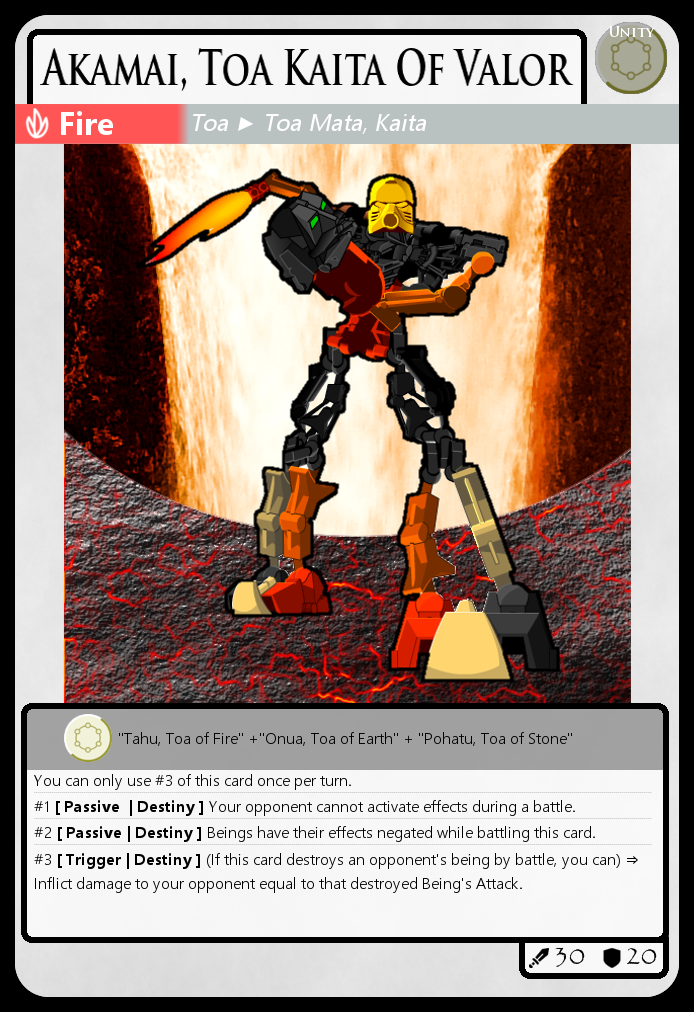
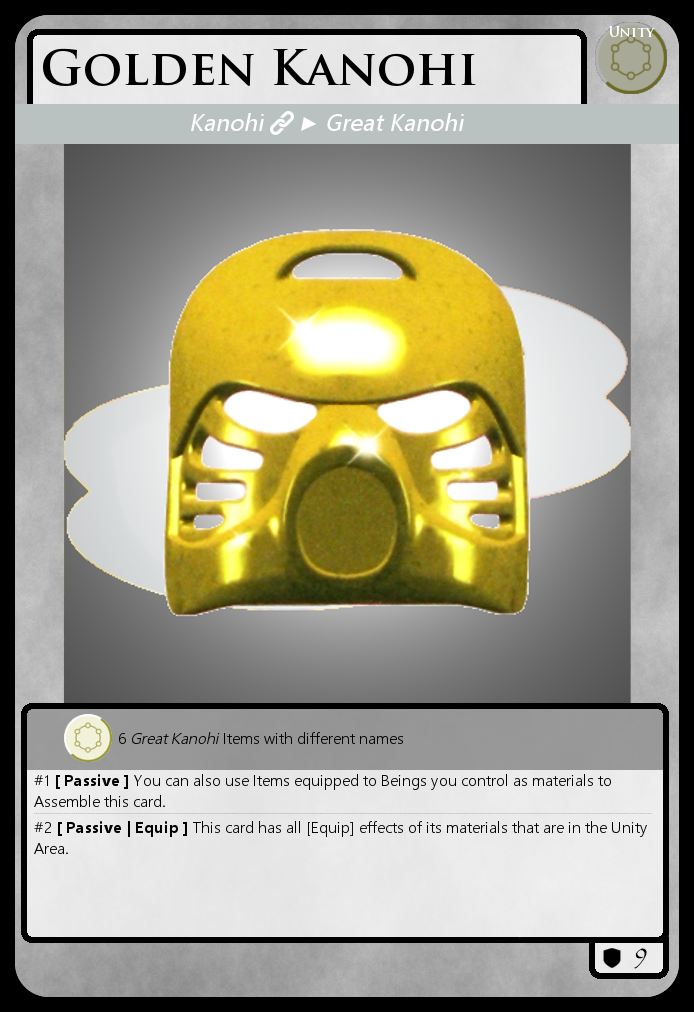
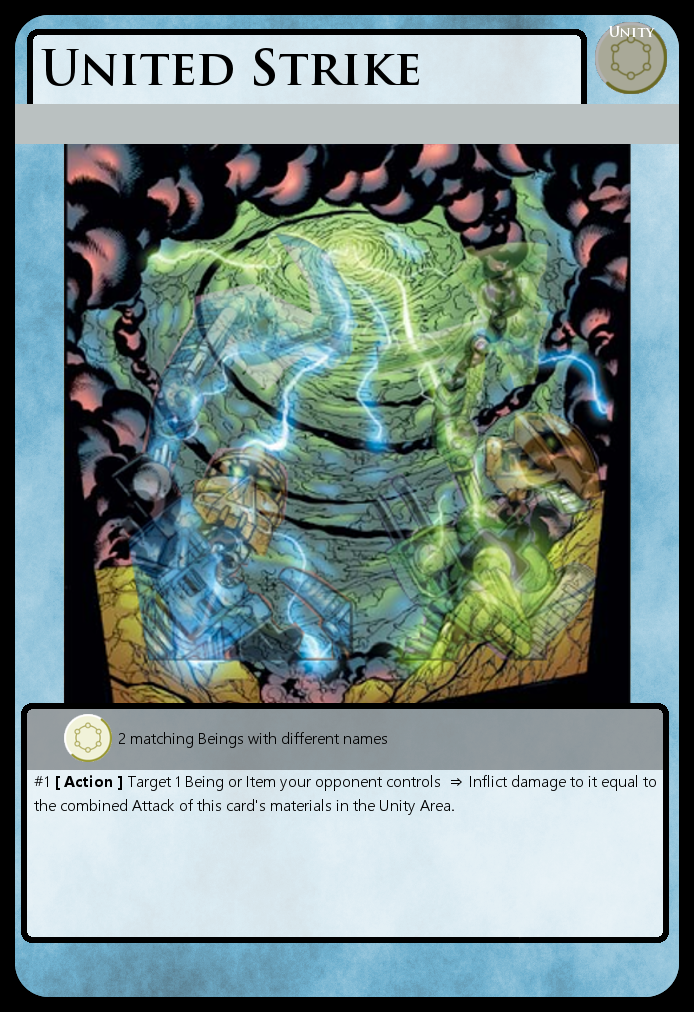
Unity Cards look mostly like regular cards and cover the same card types as well, with the exception of Locations (I imagine Spherus Magna might be an exception to that exception as the one and only Unity Location). They can be recognized as Unity Cards by two special features: A symbol labeled “Unity” without a number where you’d expect to find the duty cost, and a section at the start of the text box marked with the same symbol.
As this should ideally suggest at a glance, playing a Unity Card does not require paying a Duty Cost, but instead you have to use the listed materials. To do so, move them from the Destiny Area to the Unity Area in the sideways “idle” position. The Unity Card now enters the Destiny Area and remains there – or not, if it’s an Action. The basic card types continue to function as usual.
The instant a Unity Card exits the Destiny Area, no matter by what means (unless it goes to the Unity Area itself, maybe?), you take as many of the idle materials in the Unity Area as possible and flip them into the upright position … which I guess can’t be called “on duty” here (“ready” works, but suggestions welcome). At the start of your next turn, presumably in the same phase where the Duty cards are restored from their resting or idle state, all upright cards in the Unity Area return to the Destiny Area, as if the combination has come apart.
What this slightly involved process achieves in particular is that, in addition to Kaita-like boss monsters smoothly floating back into their components, Unity Actions functionally “blink out” the used material until the next turn – since the Action will leave the Destiny Area by itself right after resolving, causing the cards in the Unity Area to be primed for coming back at the next opportunity.
LoCation
Really, we’ve said everything that there is to say already when describing the Location Cards that go here. You can stack them in order of increasing zoom level, but only the topmost Location is active at a time. If you want to play a Location with lower zoom level than the active one, you have to remove layers from the stack until you find one with even lower zoom (or all cards are gone).
Probably should also be noted that just like when playing a card into the Destiny Area, you have to pay the Duty Cost of a Location you add to this zone.
Grave and Seal
The Grave just fills the basic role of a place where cards go after they have been used and/or removed from the field. CCGs like to have some unique name for this thing, but none of the options I’ve considered have really convinced me – “Archives”, “Chronicle”, or “Wall of History” all don’t sound right one way or another. Maybe there’s a good one I’ve missed?
The Seal is a brazen copy of Yugioh’s banishment, because I had some pretty neat design associations with that mechanic already. Namely, abilities that could non-lethally seal away someone or something, be it simple freezing or a mighty Toa Seal, were generally associated with banishing. Therefore, I have decided to already highlight this piece of flavor in the name of the location itself.
Further Mechanics
Below are some mechanics that I also figured would be nice to have, but might introduce too much additional complexity to be really worth it.
Destiny Cards
Besides combining through Unity, there is another way by which individuals in Bionicle often attain more powerful forms: Evolving under certain conditions as ordained by their Destiny. Consider as examples the transformation from Matoran into Toa, the changes brought about by Energized Protodermis, or even the Makuta turning into energy beings at some point in history.
These evolutions, I was thinking, could be represented by a type of card similar to, yet distinct from, Unity Cards. Such “Destiny Cards” would also be marked with a special cost symbol and label, as well as a dedicated materials section in their text box. However, their cost still comes with a number, and the materials tend to require a more specific setup.
How this works is that you can play a Destiny Card in either your Duty Deck or your Unity Deck. In the former case, you would be able to play it from your hand through the regular assembly process of paying the listed cost in Duty. But in the latter case, you can Assemble it from the Unity Deck for free using a material that meets its condition. Doing so will send any used materials to the Grave instead of storing them away in the Unity Area, as an evolution through Destiny is generally neither temporary nor reversible.
This gives you the opportunity to tell either a story of the evolution itself by playing a deck aiming to set up the right conditions, or a story that simply features the evolved form by playing it in your deck like any other card – no materials required. Think about it like the difference between the Toa Nuva in the Bohrok Saga and in Mask of Light.
Equipping
If you are familiar with the Bionicle YGOPro Expansion, you know it has its fair share of Equip Spells in the form of all the different Kanohi. And on each of those cards, you can find one shared clause:
If another “Kanohi” card becomes equipped to the equipped monster, destroy this card.
every Kanohi ever
This is meant to represent the simple fact that only one Kanohi can be worn and used at a time, and in order to avoid writing that over and over again, I wanted to give Virtues an equipment mechanic that inherently handles that kind of stuff.
My idea was as follows: An Item, and perhaps a Being in some cases, can have one or more of its listed Groups marked with a special symbol. This would, while in the Destiny Area, give it the non-effect ability to equip to a Being in the Destiny Area by attaching much like an Xyz Material (in particular, it also goes to the Grave if the Being leaves the Destiny Area). In this state, its effects labeled with the Equip location apply, and we say it is equipped “as” the Group that had the equip symbol (player’s choice, if multiple available). And to accomplish the single-Kanohi rule from this position, we just make it so that whenever a Being has two Items equipped as the same Group, its controller must pick one of them to send to the Grave. Of course, an equipped card can also be voluntarily removed and return to being standalone in the Destiny Area.
Beyond this, I was thinking about further extending the design space of this “equipment slot” mechanic by also allowing the equip symbol on a group name to be listed either multiple times or in combination with a number. The meaning would be that this specific item “tolerates” sharing its equip slot with up to that many others, so if you for example equip two Kanohi with an equip value of 2 (the halves of the Vahi?) to a Being, they would both be able to stay. But if only one of the pair has the value 2 and the other is a regular 1-equip, one of them needs to go. Basically, you’d need to find any legal state in which no currently equipped Item exceeds its equip value. As you can imagine, this could end up really complicated for the player to handle and isn’t really needed for all that many cases, so probably better to not go there.
More Gameplay Details
Phases
Considering all the elements introduced so far, it seems like a turn needs to be divided into at least:
- Draw Phase: Where you draw for turn.
- Ready Phase: Where time-based adjustments to cards in Unity and Duty Areas happen (rested to idle, idle to on duty/ready).
- Main Phase: Where the turn player Assembles cards, uses effects, and battles.
- End Phase: Where stuff expires.
Arguably some kind of distinct Battle Phase could be beneficial to have, but like most details of the battle system, that’s a question for a later stage of development.
Activated Effects: Order and Responses
With trigger effects and probably also quick effects in the game, there’s no getting around having some mechanism to order simultaneous activations and to dictate when and how effects can be activated in response to something.
The two well-documented examples of such a thing are Yugioh’s Chain and Magic’s Stack, both of which basically amount to resolving in reverse activation order. However, there are two main differences to be pointed out:
- Once a Chain starts resolving, it does so in one go with no room for further activations until it’s done, while the Stack allows activating more stuff between two individual resolutions.
- Chains only allow responses to the most recent Chain Link, but anything on the Stack can be responded to even if other objects have been stacked on top of it already.
The former gives long Chains that nice feeling of building tension that finally culminates in a massive, unstoppable sequence of resolutions – whatever happens, happens. The latter is what enables Chain Blocking to protect crucial trigger effects from negation, which is just a super nice part of the learning curve. So even beyond the fact that we’re operating under the conceit of repurposing effects designed for Yugioh’s system, I’m inclined to go with something like Chains just because Chains rule.
On the other hand, when it comes to ordering simultaneous trigger effects, it’s probably better not to copy Yugioh and its pedantic distinction of mandatory and optional effects. We can just keep it simple and use the same rules as more or less any game out there: Each player freely decides the order of their triggers, turn player first.
Example Card Conversions
With all that established, thank you very much for reading! Enjoy some additional cards from the Expansion that I’ve attempted to translate to the system of Virtues, but do always keep in mind a lot of the details are guesswork that is far from being suitable for a functional game.
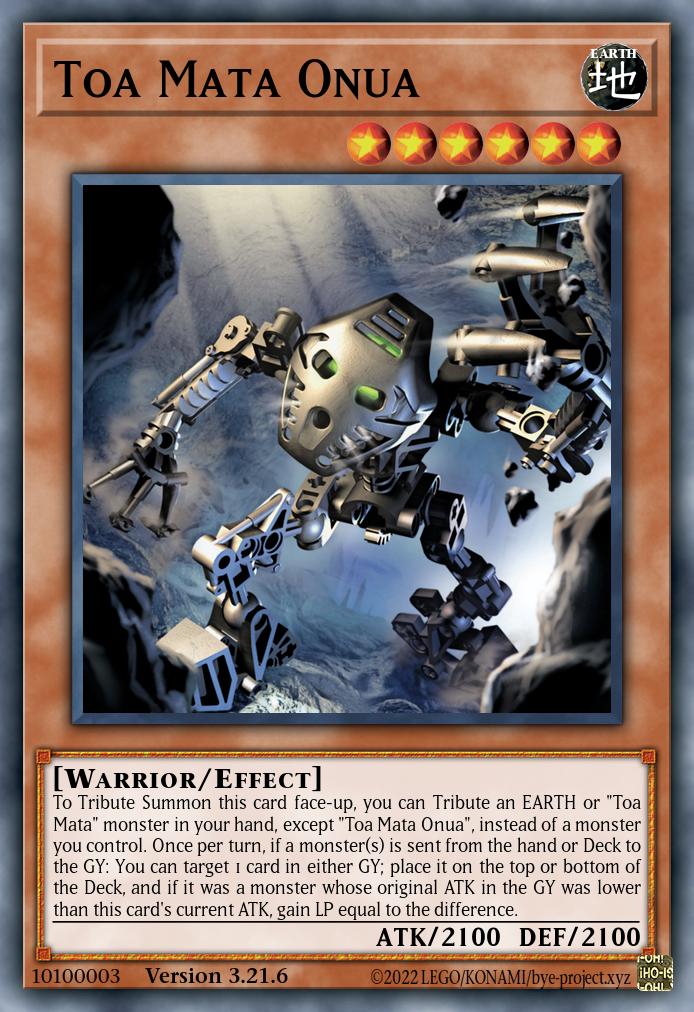
Toa Mata Onua
Effect MonsterLevel 6 | EARTH Warrior | ATK 2100 / DEF 2100To Tribute Summon this card face-up, you can Tribute an EARTH or “Toa Mata” monster in your hand, except “Toa Mata Onua”, instead of a monster you control. Once per turn, if a monster(s) is sent from the hand or Deck to the GY: You can target 1 card in either GY; place it on the top or bottom of the Deck, and if it was a monster whose original ATK in the GY was lower than this card’s current ATK, gain LP equal to the difference.
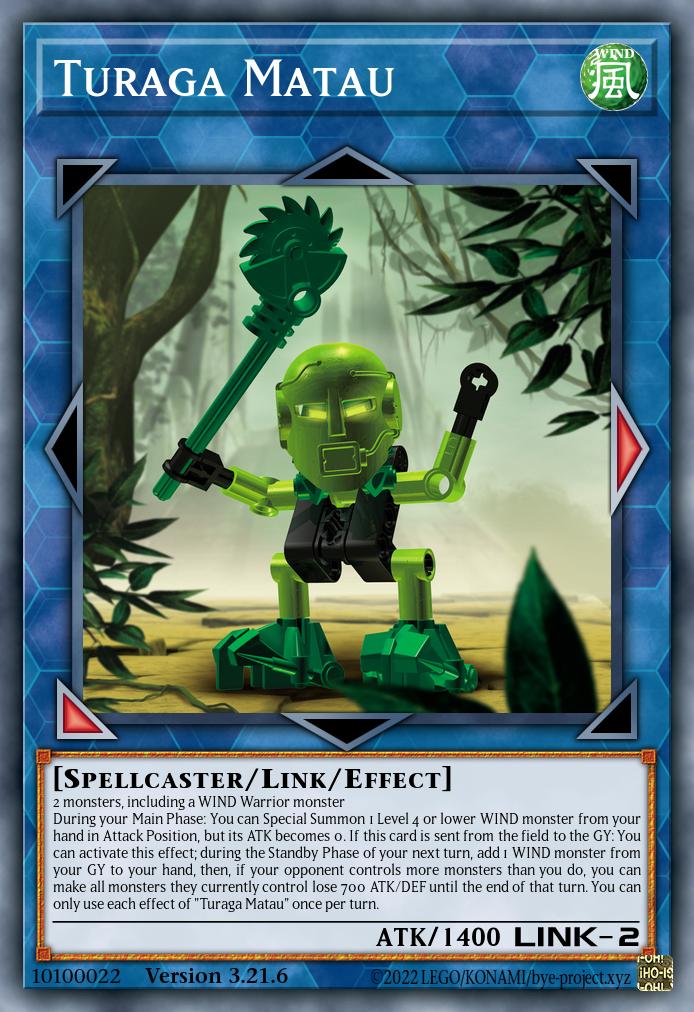
Turaga Matau
Link Effect MonsterLink-2 [↙ ▶] | WIND Spellcaster | ATK 14002 monsters, including a WIND Warrior monster
During your Main Phase: You can Special Summon 1 Level 4 or lower WIND monster from your hand in Attack Position, but its ATK becomes 0. If this card is sent from the field to the GY: You can activate this effect; during the Standby Phase of your next turn, add 1 WIND monster from your GY to your hand, then, if your opponent controls more monsters than you do, you can make all monsters they currently control lose 700 ATK/DEF until the end of that turn. You can only use each effect of “Turaga Matau” once per turn.
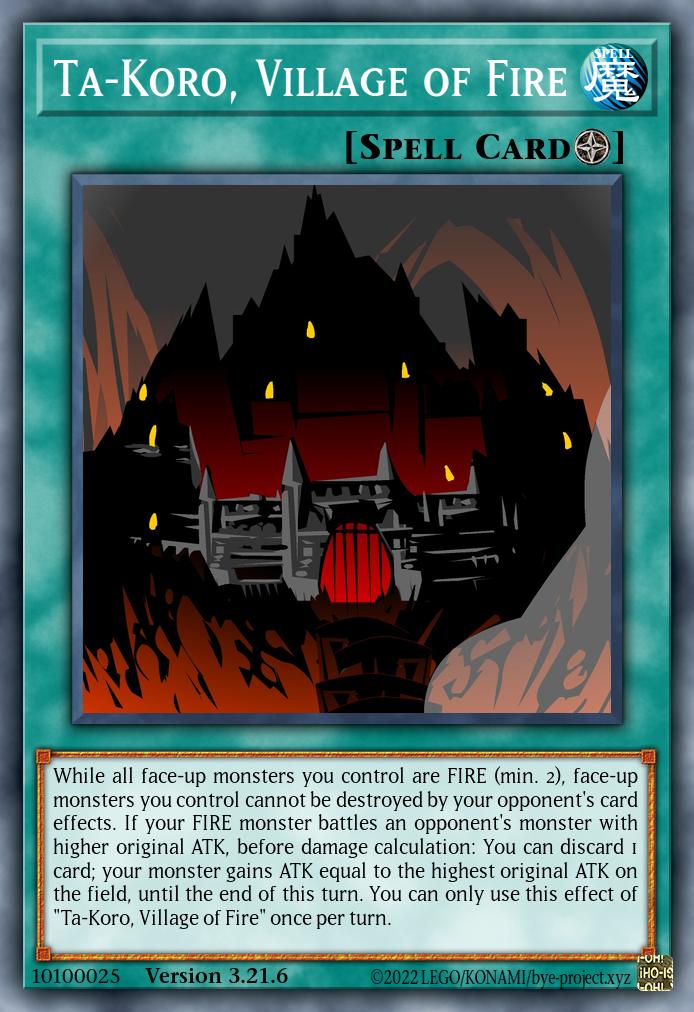
Ta-Koro, Village of Fire
Field SpellWhile all face-up monsters you control are FIRE (min. 2), face-up monsters you control cannot be destroyed by your opponent’s card effects. If your FIRE monster battles an opponent’s monster with higher original ATK, before damage calculation: You can discard 1 card; your monster gains ATK equal to the highest original ATK on the field, until the end of this turn. You can only use this effect of “Ta-Koro, Village of Fire” once per turn.
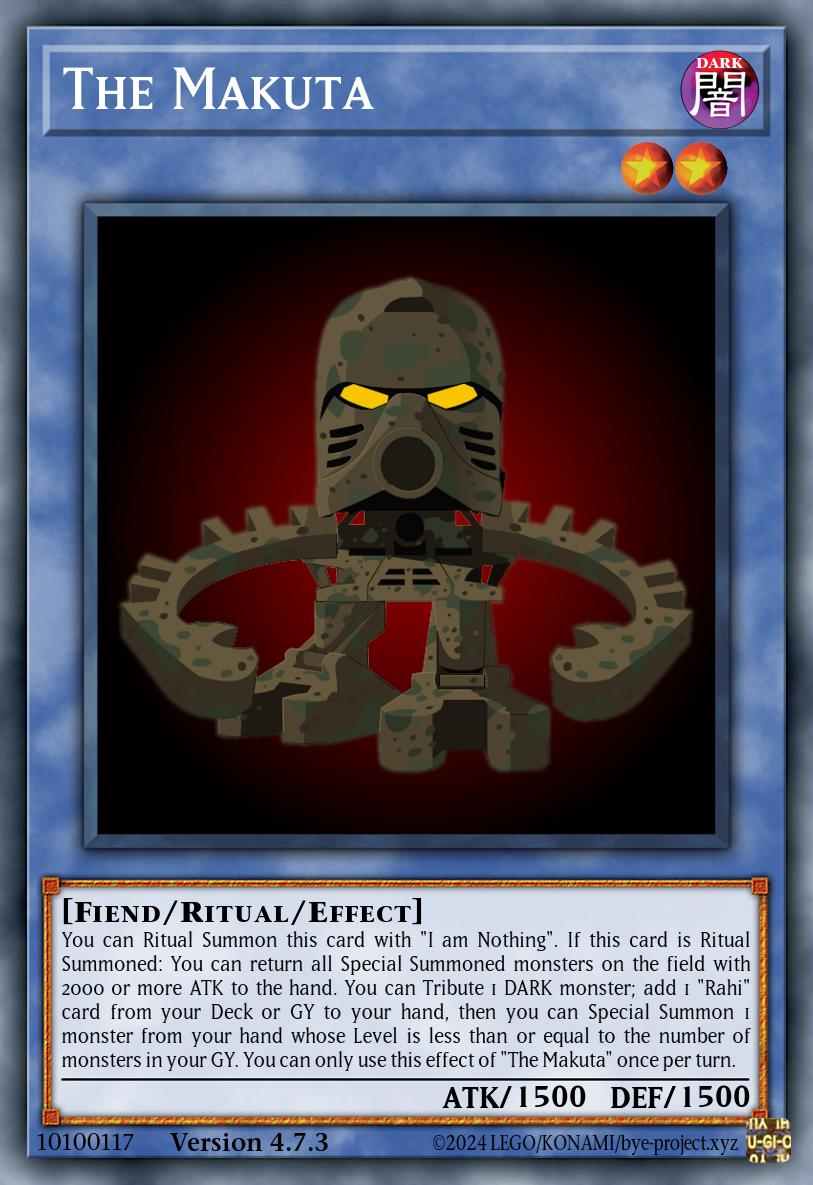
The Makuta
Ritual Effect MonsterLevel 2 | DARK Fiend | ATK 1500 / DEF 1500You can Ritual Summon this card with “I am Nothing”. If this card is Ritual Summoned: You can return all Special Summoned monsters on the field with 2000 or more ATK to the hand. You can Tribute 1 DARK monster; add 1 “Rahi” card from your Deck or GY to your hand, then you can Special Summon 1 monster from your hand whose Level is less than or equal to the number of monsters in your GY. You can only use this effect of “The Makuta” once per turn.
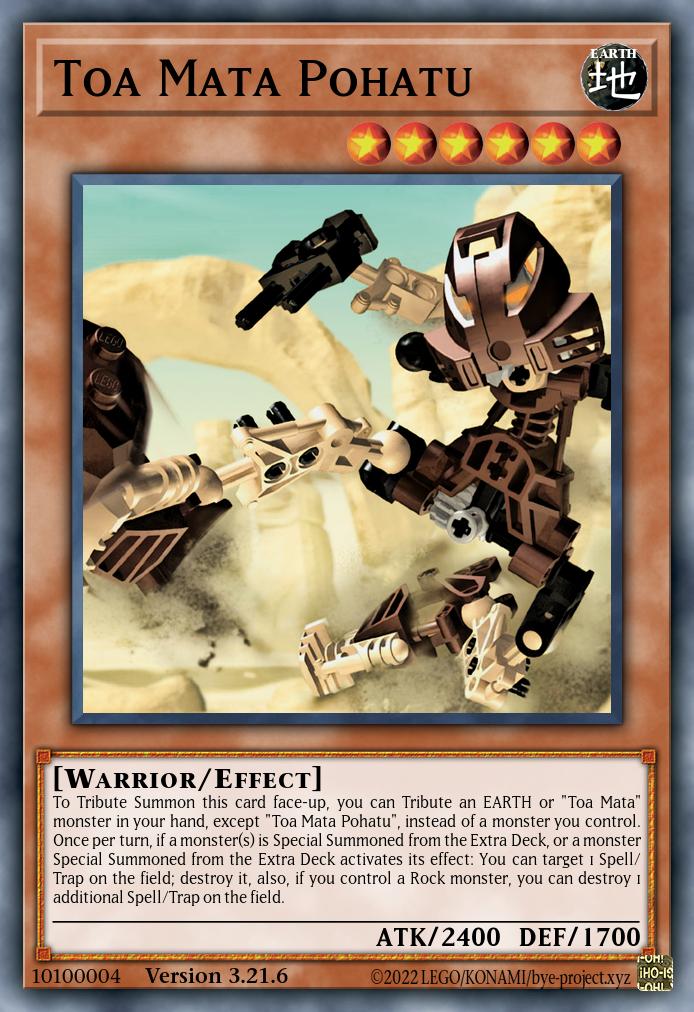
Toa Mata Pohatu
Effect MonsterLevel 6 | EARTH Warrior | ATK 2400 / DEF 1700To Tribute Summon this card face-up, you can Tribute an EARTH or “Toa Mata” monster in your hand, except “Toa Mata Pohatu”, instead of a monster you control. Once per turn, if a monster(s) is Special Summoned from the Extra Deck, or a monster Special Summoned from the Extra Deck activates its effect: You can target 1 Spell/Trap on the field; destroy it, also, if you control a Rock monster, you can destroy 1 additional Spell/Trap on the field.
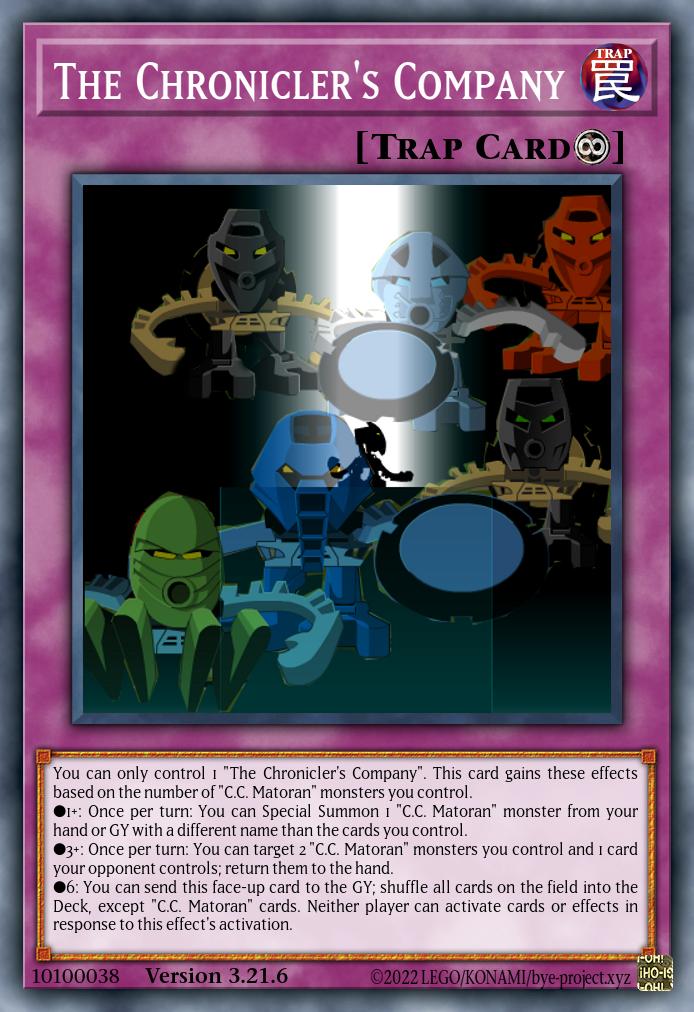
The Chronicler’s Company
Continuous TrapYou can only control 1 “The Chronicler’s Company”. This card gains these effects based on the number of “C.C. Matoran” monsters you control.
●1+: Once per turn: You can Special Summon 1 “C.C. Matoran” monster from your hand or GY with a different name than the cards you control.
●3+: Once per turn: You can target 2 “C.C. Matoran” monsters you control and 1 card your opponent controls; return them to the hand.
●6: You can send this face-up card to the GY; shuffle all cards on the field into the Deck, except “C.C. Matoran” cards. Neither player can activate cards or effects in response to this effect’s activation.

The Island of Mata Nui
Field SpellAll Normal Summoned “Toa Mata” monsters gain 600 ATK/DEF. During your Main Phase: You can reveal 1 monster in your hand and add 1 “-Koro” Field Spell that mentions that monster’s Attribute from your Deck to your hand. If you revealed a “Toa Mata” monster, you can add 1 “The Great Temple, Kini-Nui” instead. If a card in your Field Zone, except “The Island of Mata Nui”, is destroyed while this card is in your GY: You can activate this card, but banish it when it leaves the field. You can only use each effect of “The Island of Mata Nui” once per turn.
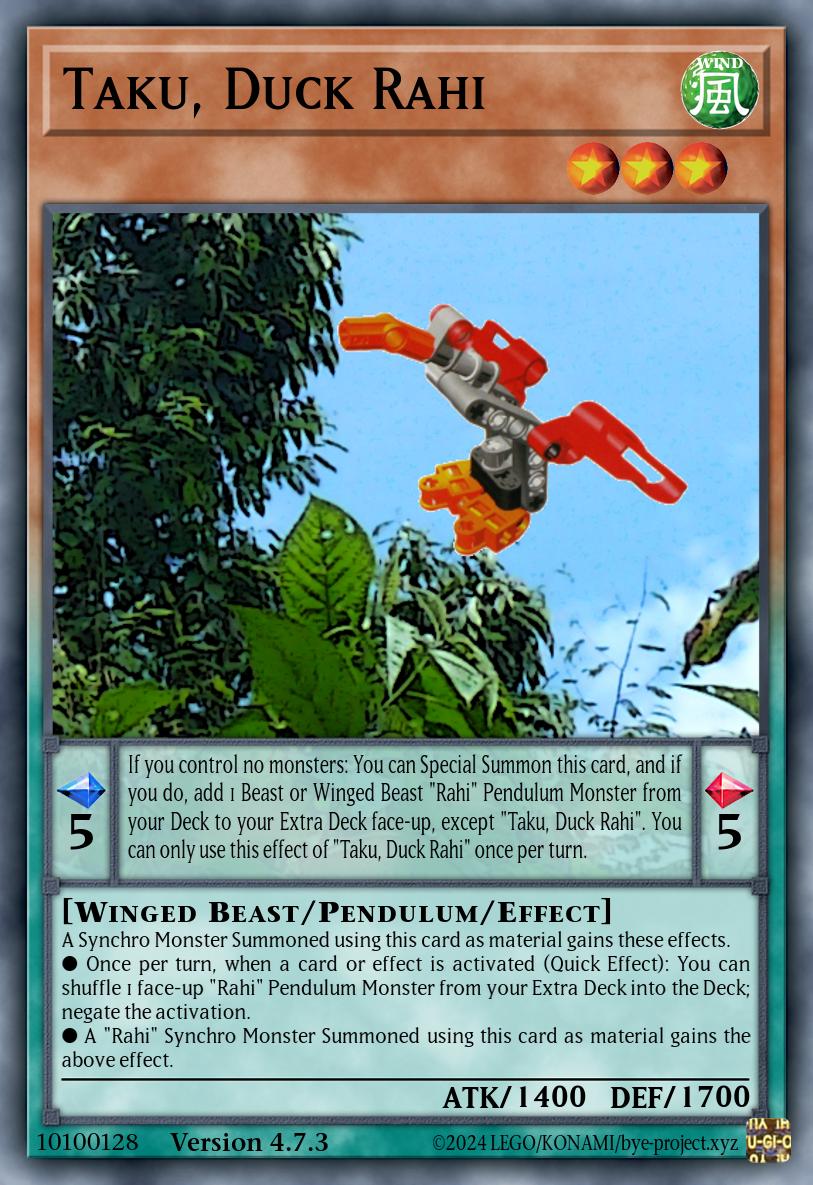
Taku, Duck Rahi
Pendulum Effect MonsterLevel 3 | Scale 5/5 | WIND Winged Beast | ATK 1400 / DEF 1700[ Pendulum Effect ]
If you control no monsters: You can Special Summon this card, and if you do, add 1 Beast or Winged Beast “Rahi” Pendulum Monster from your Deck to your Extra Deck face-up, except “Taku, Duck Rahi”. You can only use this effect of “Taku, Duck Rahi” once per turn.
—————————————-
[ Monster Effect ]
A Synchro Monster Summoned using this card as material gains these effects.
● Once per turn, when a card or effect is activated (Quick Effect): You can shuffle 1 face-up “Rahi” Pendulum Monster from your Extra Deck into the Deck; negate the activation.
● A “Rahi” Synchro Monster Summoned using this card as material gains the above effect.
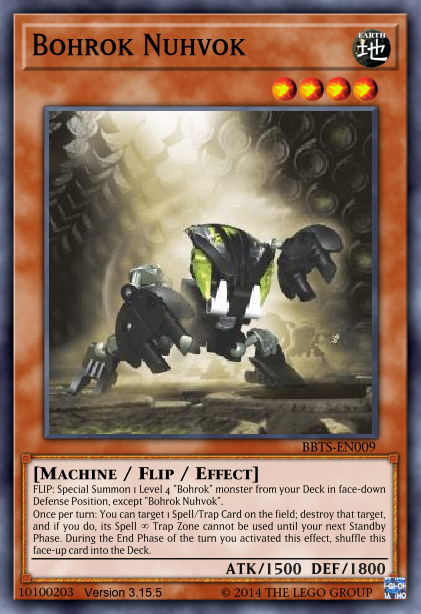
Bohrok Nuhvok
Flip Effect MonsterLevel 4 | EARTH Machine | ATK 1500 / DEF 1800FLIP: Special Summon 1 Level 4 “Bohrok” monster from your Deck in face-down Defense Position, except “Bohrok Nuhvok”.
Once per turn: You can target 1 Spell/Trap Card on the field; destroy that target, and if you do, its Spell & Trap Zone cannot be used until your next Standby Phase. During the End Phase of the turn you activated this effect, shuffle this face-up card into the Deck.

Bohrok Lehvak-Kal
Xyz Effect MonsterRank 4 | WIND Machine | ATK 1900 / DEF 24002 Level 4 “Bohrok” monsters
Place materials detached from this card on the bottom of the Deck instead of sending them to the GY. (Quick Effect): You can target 1 other card you control or in either GY; attach it to this card as material. If this card has 5 or more materials: You can detach all materials from this card, and if you do, destroy up to that many cards your opponent controls, then you can attach 1 of those destroyed cards to this card as material. You can only use each effect of “Bohrok Lehvak-Kal” once per turn.
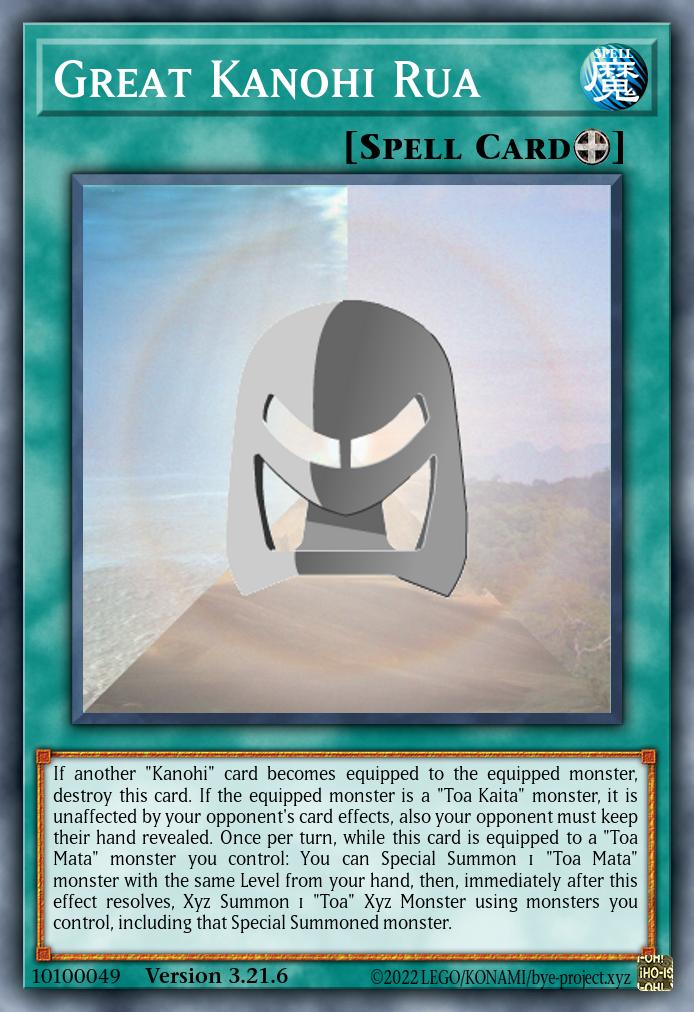
Great Kanohi Rua
Equip SpellIf another “Kanohi” card becomes equipped to the equipped monster, destroy this card. If the equipped monster is a “Toa Kaita” monster, it is unaffected by your opponent’s card effects, also your opponent must keep their hand revealed. Once per turn, while this card is equipped to a “Toa Mata” monster you control: You can Special Summon 1 “Toa Mata” monster with the same Level from your hand, then, immediately after this effect resolves, Xyz Summon 1 “Toa” Xyz Monster using monsters you control, including that Special Summoned monster.
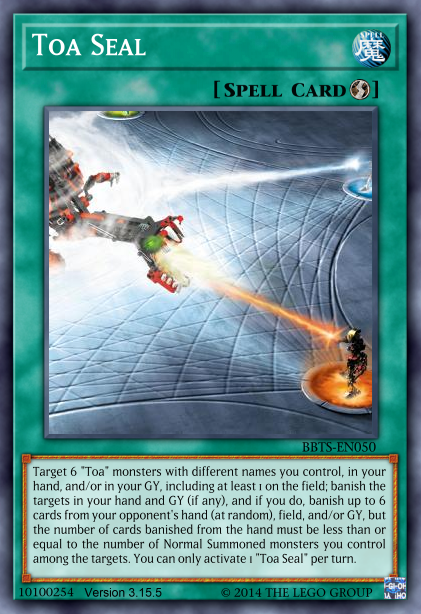
Toa Seal
Quick-Play SpellTarget 6 “Toa” monsters with different names you control, in your hand, and/or in your GY, including at least 1 on the field; banish the targets in your hand and GY (if any), and if you do, banish up to 6 cards from your opponent’s hand (at random), field, and/or GY, but the number of cards banished from the hand must be less than or equal to the number of Normal Summoned monsters you control among the targets. You can only activate 1 “Toa Seal” per turn.
Third-party icons used:
Sword icons created by Freepik – Flaticon

